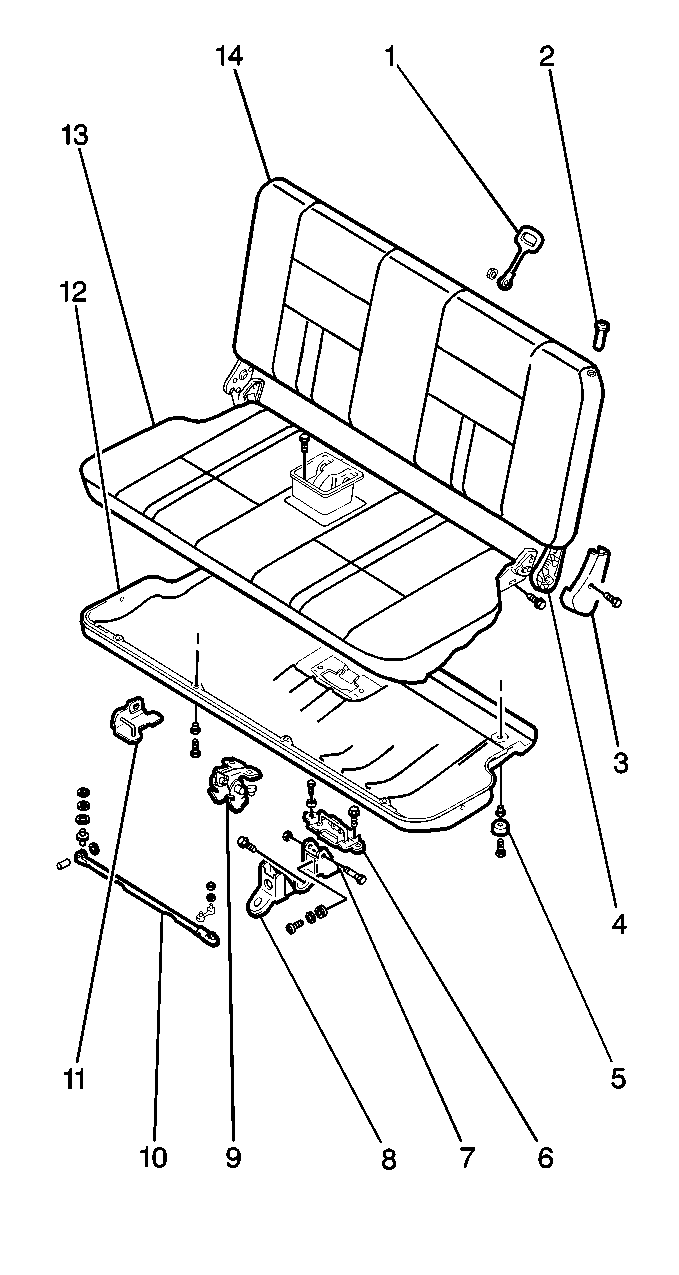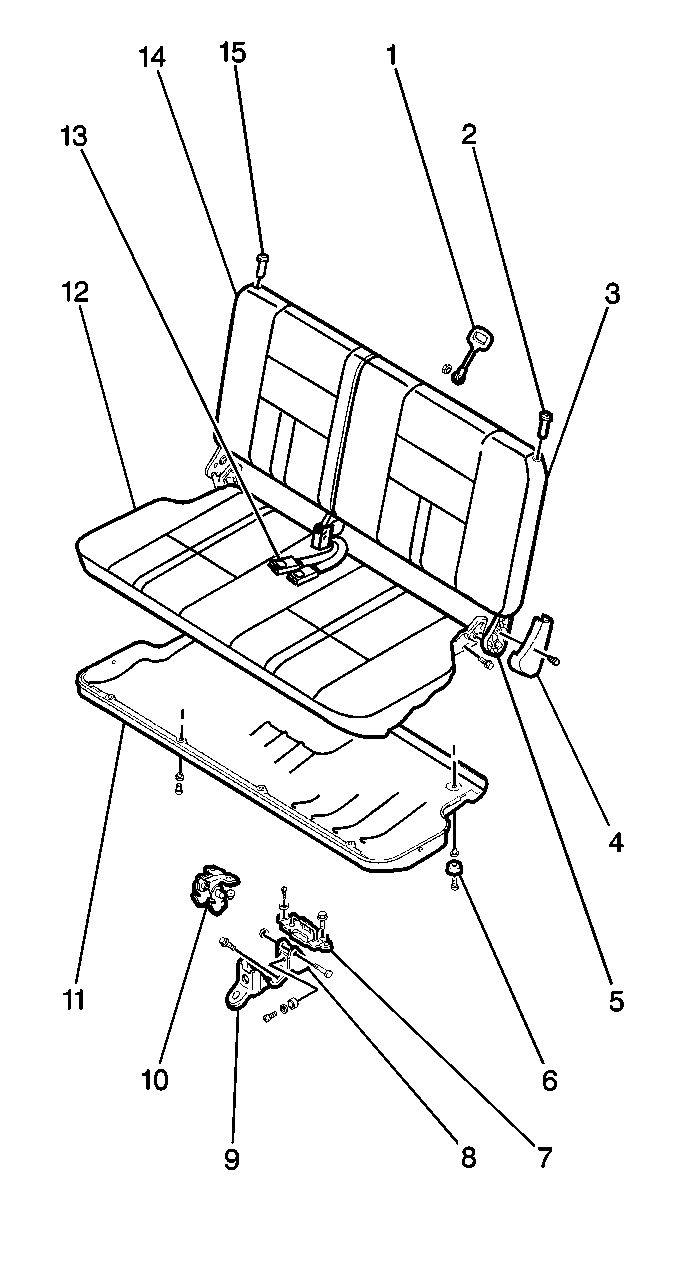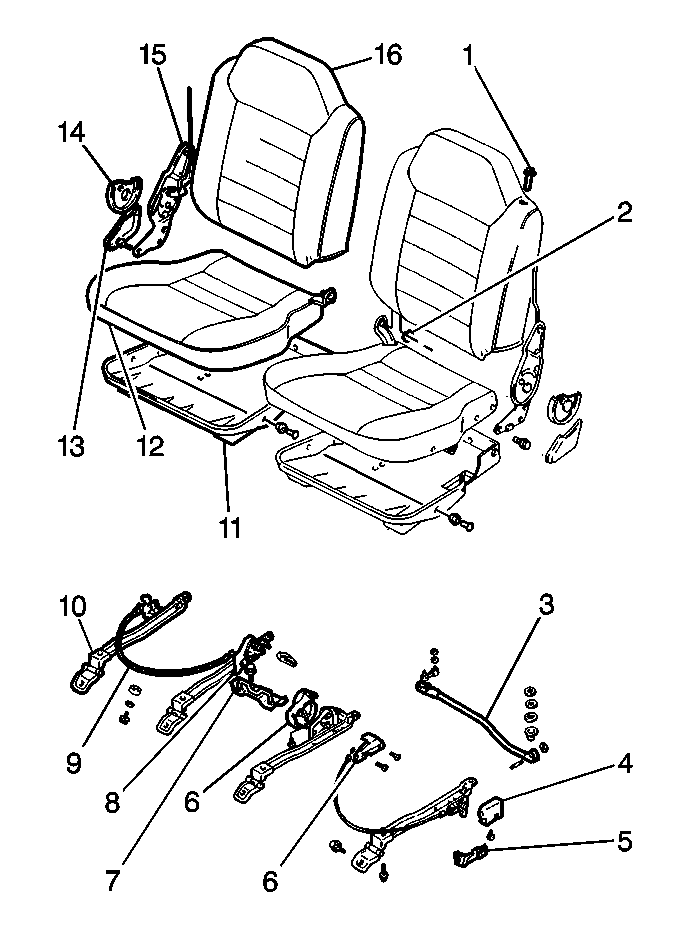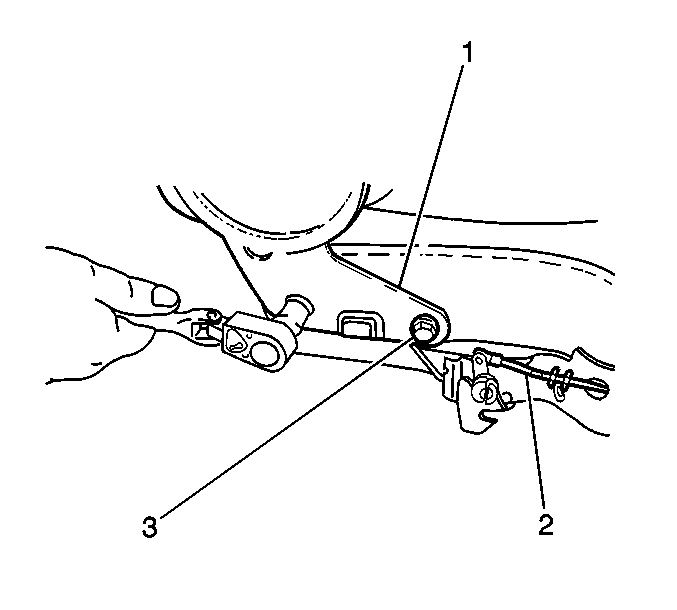Rear Seat Cushion Trim Cover Replacement 2 Door
Removal Procedure
- Remove the rear seat hinges. Refer to Rear Seat Hinge Replacement .
- Remove the following components from the rear seat:

| • | 1 support rod clip |
| • | 1 support rod pin |
| • | The support rod (10) |
| • | 1 rear seat release handle clip |
| • | 1 rear seat release handle pin |
| • | The rear seat release handle (1) |
| • | 1 screw from each rubber bumper (5) |
| • | The rubber bumpers (5) |
| • | 6 rear seat cushion trim cover screws on the bottom of the rear seat |
| • | The rear seat cushion trim cover (12) |
Installation Procedure
- Install the rear seat cushion trim cover (12) to the bottom of the rear seat. Secure the rear seat cushion trim cover (12) with the 6 screws.
- Install the rubber bumpers (5) to the rear seat. Secure each rubber bumper (5) with 1 screw.
- Install the rear seat release handle (1). Secure the rear seat release handle (1) with the following components:
- Install the support rod (10) to the rear seat. Secure the support rod (10) with the following components:
- Install the rear seat hinges to the seat. Refer to Rear Seat Hinge Replacement .

| • | 1 pin |
| • | 1 clip |
| • | 1 pin |
| • | 1 clip |
Rear Seat Cushion Trim Cover Replacement 4 Door
Removal Procedure
- Remove the rear seat from the vehicle. Refer to Rear Bench Seat Replacement .
- Gently pry and loosen the recliner mechanism lower trim cover.
- Remove the recliner mechanism lower trim cover from the seat.
- Remove the rear seat outboard rail trim cover screw.
- Remove the rear seat outboard rail trim cover from the seat.
- Remove the rear bolt from the recliner mechanism.
- Remove the rear seat latch cable from the outboard rail.
- Remove the screw from each cushion bumper (6).
- Remove both cushion bumpers (6) from the seat.
- Remove the support rod clip and pin.
- Remove the support rod from the rear seat.
- Remove the 6 rear seat cushion trim cover screws.
- Feed the rear seat latch cable through the rear seat cushion trim cover (11).
- Remove the cover (11) from the seat.

Installation Procedure
- Feed the rear seat latch cable through the rear seat cushion trim cover (11). Secure the rear seat cushion trim cover (11) to the seat with the 6 screws.
- Install the rear seat support rod to the seat. Secure the support rod with 1 clip and 1 pin.
- Install the 2 cushion bumpers (6) to the seat. Secure each cushion bumper (6) with 1 screw.
- Install the rear seat latch cable to the outboard rail.
- Install the rear bolt to the recliner mechanism.
- Install the rear seat outboard latch cover to the seat. Secure the rear seat outboard latch cover with 1 screw.
- Press the recliner mechanism lower trim cover onto the recliner mechanism.
- Install the rear seat to the vehicle. Refer to Rear Bench Seat Replacement .

Notice: Use the correct fastener in the correct location. Replacement fasteners must be the correct part number for that application. Fasteners requiring replacement or fasteners requiring the use of thread locking compound or sealant are identified in the service procedure. Do not use paints, lubricants, or corrosion inhibitors on fasteners or fastener joint surfaces unless specified. These coatings affect fastener torque and joint clamping force and may damage the fastener. Use the correct tightening sequence and specifications when installing fasteners in order to avoid damage to parts and systems.
Tighten
Tighten the rear seat recliner mechanism rear bolt to 20 N·m
15 lb ft).
Rear Seat Cushion Trim Cover Replacement 50/50 Split
Removal Procedure
- Remove the rear seat. Refer to Rear 50-50 Split Seat Replacement .
- Remove rear seat rails (10) from the rear seat. Refer to Seat Rail Replacement - Rear 50-50 Split .
- Gently pry the rear seat recliner mechanism lower trim cover (14) loose. Remove from seat.
- Remove the screw and rear seat outboard rail trim cover which secures the seat.
- Remove the rear bolt which secures the recliner mechanism (1).
- Remove the rear seat latch cable (2) which secures the outboard rail.
- Remove the screw which secures each cushion bumper and 2 cushion bumpers from the seat.
- Remove the clip, pin and support rod (3) from the rear seat.
- Remove the 6 screws from the rear seat cushion trim cover (11).
- Feed the rear seat latch cable out of the rear seat cushion trim cover.
- Remove the cover from the seat.



Installation Procedure
- Feed the rear seat latch cable through the rear seat cushion trim cover (11). Secure the cover to the seat with 6 screws.
- Install the rear seat support rod (3) to seat. Secure with the pin and the clip.
- Install 2 cushion bumpers to the seat. Secure each with the screw.
- Install the rear seat latch cable (4) to outboard rail.
- Install the rear bolt to the recliner mechanism (1).
- Install the rear seat outboard latch cover to seat. Secure with the screw.
- Install the recliner mechanism lower trim cover (14) onto the recliner mechanism.
- Install the rear seat rails to the rear seat. Refer to Seat Rail Replacement - Rear 50-50 Split .
- Install the rear seat to the vehicle. Refer to Rear 50-50 Split Seat Replacement .


Notice: Use the correct fastener in the correct location. Replacement fasteners must be the correct part number for that application. Fasteners requiring replacement or fasteners requiring the use of thread locking compound or sealant are identified in the service procedure. Do not use paints, lubricants, or corrosion inhibitors on fasteners or fastener joint surfaces unless specified. These coatings affect fastener torque and joint clamping force and may damage the fastener. Use the correct tightening sequence and specifications when installing fasteners in order to avoid damage to parts and systems.
Tighten
Tighten the rear seat recliner mechanism rear bolt to 20 N·m
(15 lb ft).

